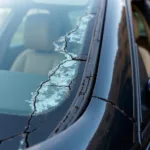Seeing paint peeling off your car can be disheartening. It not only detracts from your car’s appearance but also exposes the underlying metal to the elements, increasing the risk of rust and corrosion. Fortunately, addressing this issue isn’t always a costly trip to the auto shop. This comprehensive guide will walk you through the steps to effectively repair peeling car paint and restore your car’s finish.
Understanding Why Car Paint Peels
Before diving into the repair process, it’s crucial to understand the common culprits behind peeling paint. This knowledge can help you address the root cause and prevent future occurrences. Here are some factors that can lead to paint peeling:
- UV Damage: Prolonged exposure to the sun’s harmful ultraviolet (UV) rays can degrade the paint’s protective clear coat, causing it to become brittle and eventually peel away.
- Oxidation: When paint is exposed to oxygen and moisture over time, it undergoes a chemical reaction called oxidation. This process causes the paint to lose its elasticity, become dull, and eventually flake off.
- Improper Washing Techniques: Using harsh detergents or abrasive materials during washing can strip away the paint’s protective layers, making it more susceptible to peeling.
- Environmental Factors: Living in areas with extreme weather conditions, such as high humidity, salt air, or frequent temperature fluctuations, can put stress on the paint, leading to premature failure.
- Poor Quality Paint Job: If the original paint job was poorly executed, perhaps with insufficient surface preparation or low-quality paint, peeling can occur prematurely.
Gathering Your Paint Repair Arsenal
To tackle the task of repairing peeling paint, you’ll need the right tools and materials. Gathering everything beforehand will streamline the repair process. Here’s what you’ll need:
- Safety Gear: Protecting yourself is paramount. Wear safety glasses, gloves, and a respirator mask to safeguard your eyes, skin, and lungs.
- Cleaning Supplies: A clean surface is essential for proper adhesion. You’ll need car wash soap, a microfiber wash mitt, a cleaning solution like rubbing alcohol, and microfiber cloths.
- Sanding Supplies: Sandpaper in various grits (220, 320, 400, and possibly higher) will be needed to smooth out rough edges and prepare the surface for primer and paint. A sanding block will help maintain even pressure while sanding.
- Primer: Primer acts as a bonding agent between the bare metal and the new paint. Choose an automotive primer specifically designed for your car’s paint type.
- Paint: Selecting the right paint is crucial for a seamless repair. You’ll need both touch-up paint and clear coat. For a precise color match, locate your car’s paint code, usually found on a sticker inside the driver’s side door jamb or in the owner’s manual.
- Paint Application Tools: Depending on the size and location of the damage, you can opt for paint pens for small touch-ups, spray paint for larger areas, or both. Don’t forget painter’s tape to mask off surrounding areas you don’t want to paint.
- Clear Coat: A clear coat provides a protective layer over the base coat, adding gloss and UV protection.
A Step-by-Step Guide to Repairing Peeling Car Paint
Now that you’re familiar with the common causes and have assembled the necessary tools and materials, let’s move on to the step-by-step repair process:
1. Wash and Dry the Affected Area: Begin by thoroughly washing the affected area with car wash soap and water. Use a microfiber wash mitt to gently lift dirt and debris. Rinse the area well and dry it completely using a clean microfiber cloth.
2. Sand Down the Peeling Paint: Using 220-grit sandpaper, carefully sand down the peeling paint edges. Feather out the edges to create a smooth transition between the bare metal and the existing paint. Gradually work your way up to finer grits (320, 400, and higher if needed) to achieve a smooth and even surface.
3. Clean the Sanded Area: Once you’re satisfied with the sanding, use a cleaning solution like rubbing alcohol and a microfiber cloth to remove any sanding dust or residue. This ensures optimal adhesion of the primer and paint.
4. Prime the Bare Metal: Apply a thin, even coat of automotive primer to the bare metal areas exposed by the sanding. Allow the primer to dry completely according to the manufacturer’s instructions.
5. Sand the Primed Area (If Necessary): Once the primer is dry, lightly sand the primed area with fine-grit sandpaper (400 or higher) to create a smooth surface for the paint. Wipe away any sanding dust before proceeding.
6. Apply the Base Coat: Shake your touch-up paint or spray paint thoroughly before application. If using touch-up paint, apply thin, even coats, allowing each coat to dry before applying the next. If using spray paint, hold the can about 6-8 inches away from the surface and apply several light coats in a sweeping motion, overlapping each pass by about 50%.
7. Apply the Clear Coat: Once the base coat is dry, apply 2-3 thin coats of clear coat, allowing each coat to dry completely before applying the next. This will provide a glossy finish and protect the base coat from UV damage.
8. Buff and Polish (Optional): After the clear coat has cured for at least 24 hours, you can choose to buff and polish the repaired area to blend it seamlessly with the surrounding paint. However, this step is optional and requires additional tools and expertise.
Preventing Future Paint Peeling
While repairing peeling paint is achievable, preventing it in the first place is always the best approach. Here are some tips to safeguard your car’s paint:
- Regular Washing and Waxing: Wash your car regularly using a pH-neutral car wash soap and a microfiber wash mitt. Waxing your car every 3-4 months provides an added layer of protection against UV rays and environmental contaminants.
- Parking in the Shade: Whenever possible, park your car in the shade or use a car cover to limit its exposure to direct sunlight, especially during peak hours.
- Addressing Paint Chips Promptly: Touch up minor paint chips and scratches before they have a chance to develop into larger areas of peeling paint.
By understanding the causes, following the repair steps carefully, and adopting preventative measures, you can effectively address peeling paint on your car and keep it looking its best for years to come.
Need professional assistance with your car paint repair? Our team at CarRepairOnline is just a message away. Contact us via WhatsApp at +1(641)206-8880 or email us at cardiagtechworkshop@gmail.com. We offer 24/7 support and are always happy to help.



